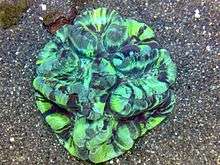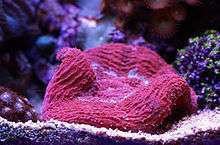Open brain coral
The open brain coral (Trachyphyllia geoffroyi) is a brightly colored free-living coral species in the family Merulinidae. It is the only species in the monotypic genus Trachyphyllia and can be found throughout the Indo-Pacific.
| Open brain coral | |
|---|---|
 | |
| Green open brain coral | |
| Scientific classification | |
| Kingdom: | Animalia |
| Phylum: | Cnidaria |
| Class: | Anthozoa |
| Order: | Scleractinia |
| Family: | Merulinidae |
| Genus: | Trachyphyllia Milne Edwards & Haime, 1849 |
| Species: | T. geoffroyi |
| Binomial name | |
| Trachyphyllia geoffroyi Audouin, 1826[1] | |
| Synonyms | |
|
List (Genus)
(Species)
| |
Description
Open brain corals can be solitary or colonial.[2] They are small corals, rarely reaching over 20 cm in diameter.[3] They are free-living and exhibit a flabello-meandroid growth form, meaning they have distinct valley regions separated by walls.[4][5] In colonial forms, the valley regions can contain multiple individual polyps.[5] Complexity of valley regions can range; some are hourglass shaped while other cans be highly lobed.[2] They typically have bilateral symmetry.[4] During the day when the polyp is closed, the coral is covered by a mantle that extends beyond the skeleton, but can retract when disturbed.[4][5] Polyps and mantle are very fleshy.[4] Colonies can be blue, green, yellow, brown, and are often vibrantly colored.[4][5]
The open brain coral is known to host a species of gall crab, Lithoscaptus semperi.[6]
Distribution and habitat

Open brain corals can be found throughout the Indo-Pacific, from the Red Sea to New Caledonia. They are found up to a maximum depth of 40 meters.[3]
Open brain corals are less common directly in coral reef communities, and are more often found on sandy reef slopes, around continental islands, and lagoons.[2][5][3] Open brain corals can often be found near other free-living corals.[3][7] Large colonies of open brain corals are uncommon, and are typically only observed in marine protected areas.[3]
Threats
The IUCN lists open brain corals as "near threatened" due to habitat loss and over-harvesting for the aquarium trade.[3] The biggest exporter of open brain coral is Indonesia. In 2005, Indonesia exported over 60,000 open brain corals for use in the aquarium trade.[3]
Other threats to open brain corals include disease, acidification, and severe storms.[3]
References
- "Trachyphyllia geoffroyi". WoRMS. World Register of Marine Species. 2011. Retrieved January 20, 2012.
- Best, M.B. and Hoeksema, B.W. (1987). "New observations on scleractinian corals from Indonesia: 1. Free-living species belonging to the Faviina". Zoologische Mededelingen. 61 (27): 1–11.CS1 maint: multiple names: authors list (link)
- "Trachyphyllia geoffroyi". IUCN Red List of Threatened Species. Retrieved 2018-03-31.
- "WoRMS - World Register of Marine Species - Trachyphyllia geoffroyi (Audouin, 1826)". www.marinespecies.org. Retrieved 2018-03-31.
- "Corals of the World". www.coralsoftheworld.org. Retrieved 2018-03-31.
- van der Meij, Sancia E.T. (2015-04-27). "A new gall crab species (Brachyura, Cryptochiridae) associated with the free-living coral Trachyphyllia geoffroyi (Scleractinia, Merulinidae)". ZooKeys. 500: 61–72. doi:10.3897/zookeys.500.9244. ISSN 1313-2970. PMC 4432240.
- Veron, J.E.N. (1986). Corals of Australia and the Indo-Pacific. London: Angus & Robertson Publishers. p. 538.
